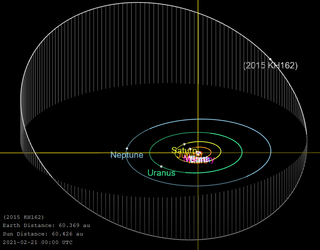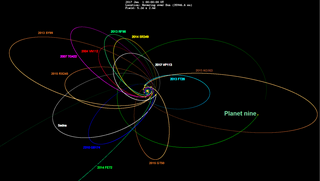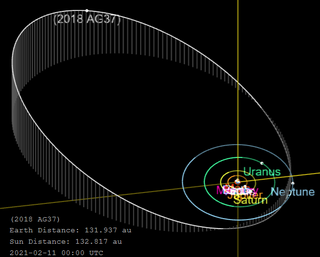Related Research Articles
(181902) 1999 RD215 is a trans-Neptunian object of the scattered disc, approximately 148 kilometers in diameter. It was discovered on 6 September 1999, by American astronomers Chad Trujillo, Jane Luu, and David Jewitt at the Mauna Kea Observatories, Hawaii.

(612584) 2003 QX113 is a large trans-Neptunian object from the scattered disc located in the outermost region of the Solar System. It is one of the most distant objects from the Sun at 60.5 AU. It was discovered by astronomers with the Canada–France Ecliptic Plane Survey at Mauna Kea Observatories, Hawaii, when it was near aphelion on 31 August 2003. It was provisionally designated 2003 QX113.
(589683) 2010 RF43, provisionally designated: 2010 RF43, is a large trans-Neptunian object orbiting in the scattered disc in the outermost regions of the Solar System. The object was discovered on 9 September 2010, by American astronomers David Rabinowitz, Megan Schwamb and Suzanne Tourtellotte at ESO's La Silla Observatory in northern Chile.
(445473) 2010 VZ98, provisional designation 2010 VZ98, is a trans-Neptunian object of the scattered disc, orbiting the Sun in the outermost region of the Solar System. It has a diameter of approximately 400 kilometers.
2010 TJ is a trans-Neptunian object from the scattered disc in the outermost region of the Solar System and measures approximately 460 kilometers in diameter. It was first observed by American astronomers David Rabinowitz, Megan Schwamb, and Suzanne Tourtellotte at ESO's La Silla Observatory in northern Chile on 2 October 2010.

2015 KH162 is a large trans-Neptunian object orbiting in the scattered disc region of the outermost Solar System. First observed in 2015, this minor planet is one of the most distant objects from the Sun at 60.6 AU, or twice as far as Neptune.
(523719) 2014 LM28, provisional designation 2014 LM28, is a trans-Neptunian object and centaur, approximately 46 kilometers (29 miles) in diameter. It was discovered on 16 May 2013, by the Pan-STARRS 1 survey at Haleakala Observatory, Hawaii, United States. The object's orbit is highly inclined and very eccentric, with a perihelion closer to the Sun than Uranus and at an aphelion 17 times farther from the Sun than Neptune.

2014 UZ224 is a trans-Neptunian object and possible dwarf planet orbiting in the scattered disc of the outermost Solar System. As of 2021, it is approximately 89.7 AU (13.42 billion km) from the Sun, and will slowly decrease in distance until it reaches its perihelion of 38 AU in 2142. The discoverers have nicknamed it "DeeDee" for "Distant Dwarf".

2015 KG163, also known as o5m52, is a trans-Neptunian object from the outermost region of the Solar System, approximately 102 kilometers (63 miles) in diameter. It was first observed on 24 May 2015, by astronomers of the Outer Solar System Origins Survey using the Canada–France–Hawaii Telescope at Mauna Kea Observatories, Hawaii, United States. With an observation arc of 2 years, it passed perihelion around August 2022 at a velocity of 6.5 km/s with respect to the Sun.
(506479) 2003 HB57, is an extreme trans-Neptunian object of the extended scattered disc in the outermost region of the Solar System, approximately 180 kilometers in diameter. It was discovered by astronomers at the Mauna Kea Observatory on 26 April 2003.
(543354) 2014 AN55 (prov. designation:2014 AN55) is a trans-Neptunian object in the scattered disc, located in the outermost region of the Solar System, that measures approximately 600 kilometres (370 mi) in diameter. It was discovered on 25 January 2014, by astronomers with the Pan-STARRS survey at Haleakala Observatory on the island of Maui, Hawaii, in the United States.
(523727) 2014 NW65, provisional designation: 2014 NW65, is a large centaur from the outer Solar System, approximately 220 kilometers (140 miles) in diameter. It was discovered on 14 July 2010 by astronomers with the Pan-STARRS-1 survey at Haleakala Observatory, Hawaii, in the United States. According to American astronomer Michael Brown, it is "possibly" a dwarf planet. The minor planet was numbered in 2018 and has not been named.

2018 AG37 is a distant trans-Neptunian object and centaur that was discovered 132.2 ± 1.5 AU (19.78 ± 0.22 billion km) from the Sun, farther than any other currently observable known object in the Solar System. Imaged in January 2018 during a search for the hypothetical Planet Nine, the confirmation of this object was announced in a press release in February 2021 by astronomers Scott Sheppard, David Tholen, and Chad Trujillo. The object was nicknamed "FarFarOut" to emphasize its distance from the Sun.

(620094) 2016 AJ193 (provisional designation 2016 AJ193; also known as 2010 KV134) is a near-Earth object and potentially hazardous asteroid of the Apollo group, approximately 1.4 kilometres (0.87 mi) in diameter. It was discovered on 17 May 2010 by the Wide-field Infrared Survey Explorer (WISE) satellite, but was lost until it was reobserved on 16 January 2016. With an observation arc over 11 years, 2016 AJ193 has a well-determined orbit and trajectory through the year 2086. The asteroid's orbit is only potentially hazardous on a time scale of thousands of years.
2014 UE228 is a trans-Neptunian object from the outermost region of the Solar System. The object is in a rare 3:8 resonance with Neptune and measures approximately 93 kilometers (58 miles) in diameter. It was first observed on 22 October 2014, by astronomers with the Outer Solar System Origins Survey at the Mauna Kea Observatories, Hawaii, and was provisionally designated 2014 UE228. As of 2021, it has not been numbered.
2019 EU5 is an extreme trans-Neptunian object from the scattered disc on a highly eccentric orbit in the outermost region of the Solar System. It was discovered on 5 March 2019, by American astronomers Scott Sheppard, David Tholen, and Chad Trujillo at Mauna Kea Observatories in Hawaii, and announced on 17 December 2021. It was 83.4 astronomical units from the Sun when it was discovered, making it one of the most distant known Solar System objects from the Sun as of December 2021. It has been identified in precovery images from 6 January 2016.
2020 BE102 is a trans-Neptunian object in the scattered disc, around 350 kilometres (220 miles) in diameter. It was discovered on 24 January 2020, by American astronomers Scott Sheppard, David Tholen, and Chad Trujillo using the 8.2-meter Subaru Telescope of the Mauna Kea Observatories in Hawaii, and announced on 31 May 2021. It was 111.2 astronomical units from the Sun when it was discovered, making it the third-farthest known Solar System object from the Sun as of May 2022, after 2018 VG18 (124 AU) and 2018 AG37 (~132 AU).
2021 LL37 is a large trans-Neptunian object in the scattered disc, around 600 kilometres (370 miles) in diameter. It was discovered on 12 June 2021, by American astronomers Scott Sheppard and Chad Trujillo using Cerro Tololo Inter-American Observatory's Dark Energy Camera in Chile, and announced on 31 May 2022. It was 73.9 astronomical units from the Sun when it was discovered, making it one of the most distant known Solar System objects from the Sun as of May 2022. It has been identified in precovery images from as far back as 28 April 2014.
2021 RR205 is an extreme trans-Neptunian object and sednoid discovered by astronomers Scott Sheppard, David Tholen, and Chad Trujillo with the Subaru Telescope at Mauna Kea Observatory on 5 September 2021. It resides beyond the outer extent of the Kuiper belt on a distant and highly eccentric orbit detached from Neptune's gravitational influence, with a large perihelion distance of 55.5 astronomical units (AU). Its large orbital semi-major axis (~1,000 AU) suggests it is potentially from the inner Oort cloud. Like 2013 SY99, 2021 RR205 lies in the 50–75 AU perihelion gap that separates the detached objects from the more distant sednoids; dynamical studies indicate that such objects in the inner edge this gap weakly experience "diffusion", or inward orbital migration due to minuscule perturbations by Neptune.
2020 MK53 is a trans-Neptunian object in the scattered disc, around 550 kilometres (340 miles) in diameter. It was discovered on 22 June 2020 by the New Horizons KBO Search-Subaru survey using the 8.2-meter Subaru Telescope of the Mauna Kea Observatories in Hawaii, and announced on 7 April 2023 (MPS 1836391, MPO 735634). It was 160 astronomical units from the Sun when it was discovered, making it the farthest known Solar System object from the Sun as of September 2023, well ahead of 2018 VG18 (124 AU) and 2018 AG37 (~132 AU). Given its very short data-arc the only reliable information is in its range (156±4 AU) and range-rate (-0.04 km/s), which suggests that it is close to its aphelion.
References
- 1 2 3 4 "MPEC 2021-Y28 : 2021 DR15". Minor Planet Electronic Circular. Minor Planet Center. 17 December 2021. Retrieved 17 December 2021.
- 1 2 3 "JPL Small-Body Database Browser: (2021 DR15)" (2021-12-06 last obs.). Jet Propulsion Laboratory . Retrieved 17 December 2021.
- ↑ "List Of Centaurs and Scattered-Disk Objects". Minor Planet Center. International Astronomical Union. Retrieved 17 December 2021.
- 1 2 3 "2021 DR15". Minor Planet Center. International Astronomical Union. Retrieved 17 December 2021.
- ↑ "Asteroid Size Estimator". Center for Near Earth Object Studies. Jet Propulsion Laboratory. Retrieved 17 December 2021.




